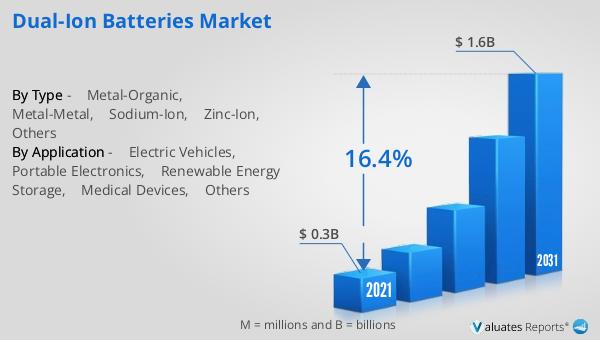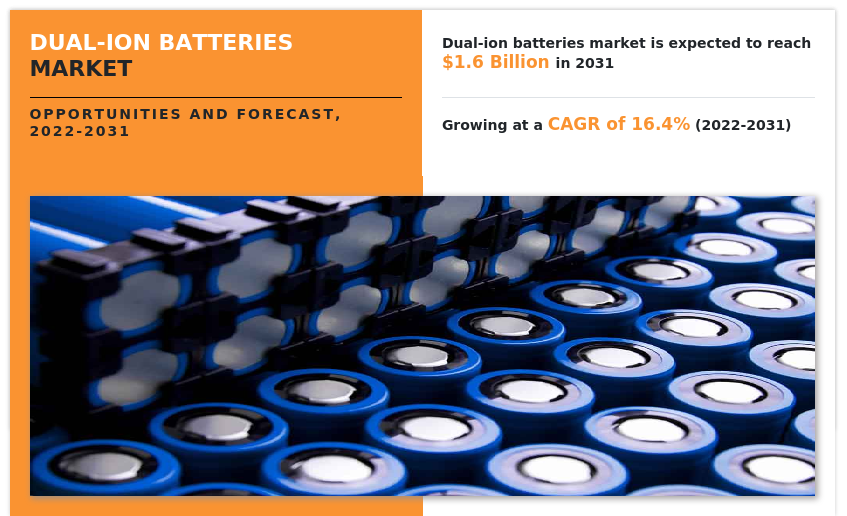LIST OF TABLES
TABLE 01. GLOBAL DUAL-ION BATTERIES MARKET, BY TYPE, 2021-2031 ($MILLION)
TABLE 02. DUAL-ION BATTERIES MARKET FOR METAL-ORGANIC, BY REGION, 2021-2031 ($MILLION)
TABLE 03. DUAL-ION BATTERIES MARKET FOR METAL-METAL, BY REGION, 2021-2031 ($MILLION)
TABLE 04. DUAL-ION BATTERIES MARKET FOR SODIUM-ION, BY REGION, 2021-2031 ($MILLION)
TABLE 05. DUAL-ION BATTERIES MARKET FOR ZINC-ION, BY REGION, 2021-2031 ($MILLION)
TABLE 06. DUAL-ION BATTERIES MARKET FOR OTHERS, BY REGION, 2021-2031 ($MILLION)
TABLE 07. GLOBAL DUAL-ION BATTERIES MARKET, BY APPLICATION, 2021-2031 ($MILLION)
TABLE 08. DUAL-ION BATTERIES MARKET FOR ELECTRIC VEHICLES, BY REGION, 2021-2031 ($MILLION)
TABLE 09. DUAL-ION BATTERIES MARKET FOR PORTABLE ELECTRONICS, BY REGION, 2021-2031 ($MILLION)
TABLE 10. DUAL-ION BATTERIES MARKET FOR RENEWABLE ENERGY STORAGE, BY REGION, 2021-2031 ($MILLION)
TABLE 11. DUAL-ION BATTERIES MARKET FOR MEDICAL DEVICES, BY REGION, 2021-2031 ($MILLION)
TABLE 12. DUAL-ION BATTERIES MARKET FOR OTHERS, BY REGION, 2021-2031 ($MILLION)
TABLE 13. DUAL-ION BATTERIES MARKET, BY REGION, 2021-2031 ($MILLION)
TABLE 14. NORTH AMERICA DUAL-ION BATTERIES MARKET, BY TYPE, 2021-2031 ($MILLION)
TABLE 15. NORTH AMERICA DUAL-ION BATTERIES MARKET, BY APPLICATION, 2021-2031 ($MILLION)
TABLE 16. NORTH AMERICA DUAL-ION BATTERIES MARKET, BY COUNTRY, 2021-2031 ($MILLION)
TABLE 17. U.S. DUAL-ION BATTERIES MARKET, BY TYPE, 2021-2031 ($MILLION)
TABLE 18. U.S. DUAL-ION BATTERIES MARKET, BY APPLICATION, 2021-2031 ($MILLION)
TABLE 19. CANADA DUAL-ION BATTERIES MARKET, BY TYPE, 2021-2031 ($MILLION)
TABLE 20. CANADA DUAL-ION BATTERIES MARKET, BY APPLICATION, 2021-2031 ($MILLION)
TABLE 21. MEXICO DUAL-ION BATTERIES MARKET, BY TYPE, 2021-2031 ($MILLION)
TABLE 22. MEXICO DUAL-ION BATTERIES MARKET, BY APPLICATION, 2021-2031 ($MILLION)
TABLE 23. EUROPE DUAL-ION BATTERIES MARKET, BY TYPE, 2021-2031 ($MILLION)
TABLE 24. EUROPE DUAL-ION BATTERIES MARKET, BY APPLICATION, 2021-2031 ($MILLION)
TABLE 25. EUROPE DUAL-ION BATTERIES MARKET, BY COUNTRY, 2021-2031 ($MILLION)
TABLE 26. GERMANY DUAL-ION BATTERIES MARKET, BY TYPE, 2021-2031 ($MILLION)
TABLE 27. GERMANY DUAL-ION BATTERIES MARKET, BY APPLICATION, 2021-2031 ($MILLION)
TABLE 28. FRANCE DUAL-ION BATTERIES MARKET, BY TYPE, 2021-2031 ($MILLION)
TABLE 29. FRANCE DUAL-ION BATTERIES MARKET, BY APPLICATION, 2021-2031 ($MILLION)
TABLE 30. ITALY DUAL-ION BATTERIES MARKET, BY TYPE, 2021-2031 ($MILLION)
TABLE 31. ITALY DUAL-ION BATTERIES MARKET, BY APPLICATION, 2021-2031 ($MILLION)
TABLE 32. UK DUAL-ION BATTERIES MARKET, BY TYPE, 2021-2031 ($MILLION)
TABLE 33. UK DUAL-ION BATTERIES MARKET, BY APPLICATION, 2021-2031 ($MILLION)
TABLE 34. SPAIN DUAL-ION BATTERIES MARKET, BY TYPE, 2021-2031 ($MILLION)
TABLE 35. SPAIN DUAL-ION BATTERIES MARKET, BY APPLICATION, 2021-2031 ($MILLION)
TABLE 36. REST OF EUROPE DUAL-ION BATTERIES MARKET, BY TYPE, 2021-2031 ($MILLION)
TABLE 37. REST OF EUROPE DUAL-ION BATTERIES MARKET, BY APPLICATION, 2021-2031 ($MILLION)
TABLE 38. ASIA-PACIFIC DUAL-ION BATTERIES MARKET, BY TYPE, 2021-2031 ($MILLION)
TABLE 39. ASIA-PACIFIC DUAL-ION BATTERIES MARKET, BY APPLICATION, 2021-2031 ($MILLION)
TABLE 40. ASIA-PACIFIC DUAL-ION BATTERIES MARKET, BY COUNTRY, 2021-2031 ($MILLION)
TABLE 41. CHINA DUAL-ION BATTERIES MARKET, BY TYPE, 2021-2031 ($MILLION)
TABLE 42. CHINA DUAL-ION BATTERIES MARKET, BY APPLICATION, 2021-2031 ($MILLION)
TABLE 43. JAPAN DUAL-ION BATTERIES MARKET, BY TYPE, 2021-2031 ($MILLION)
TABLE 44. JAPAN DUAL-ION BATTERIES MARKET, BY APPLICATION, 2021-2031 ($MILLION)
TABLE 45. INDIA DUAL-ION BATTERIES MARKET, BY TYPE, 2021-2031 ($MILLION)
TABLE 46. INDIA DUAL-ION BATTERIES MARKET, BY APPLICATION, 2021-2031 ($MILLION)
TABLE 47. SOUTH KOREA DUAL-ION BATTERIES MARKET, BY TYPE, 2021-2031 ($MILLION)
TABLE 48. SOUTH KOREA DUAL-ION BATTERIES MARKET, BY APPLICATION, 2021-2031 ($MILLION)
TABLE 49. AUSTRALIA DUAL-ION BATTERIES MARKET, BY TYPE, 2021-2031 ($MILLION)
TABLE 50. AUSTRALIA DUAL-ION BATTERIES MARKET, BY APPLICATION, 2021-2031 ($MILLION)
TABLE 51. REST OF ASIA-PACIFIC DUAL-ION BATTERIES MARKET, BY TYPE, 2021-2031 ($MILLION)
TABLE 52. REST OF ASIA-PACIFIC DUAL-ION BATTERIES MARKET, BY APPLICATION, 2021-2031 ($MILLION)
TABLE 53. LAMEA DUAL-ION BATTERIES MARKET, BY TYPE, 2021-2031 ($MILLION)
TABLE 54. LAMEA DUAL-ION BATTERIES MARKET, BY APPLICATION, 2021-2031 ($MILLION)
TABLE 55. LAMEA DUAL-ION BATTERIES MARKET, BY COUNTRY, 2021-2031 ($MILLION)
TABLE 56. BRAZIL DUAL-ION BATTERIES MARKET, BY TYPE, 2021-2031 ($MILLION)
TABLE 57. BRAZIL DUAL-ION BATTERIES MARKET, BY APPLICATION, 2021-2031 ($MILLION)
TABLE 58. SOUTH AFRICA DUAL-ION BATTERIES MARKET, BY TYPE, 2021-2031 ($MILLION)
TABLE 59. SOUTH AFRICA DUAL-ION BATTERIES MARKET, BY APPLICATION, 2021-2031 ($MILLION)
TABLE 60. SAUDI ARABIA DUAL-ION BATTERIES MARKET, BY TYPE, 2021-2031 ($MILLION)
TABLE 61. SAUDI ARABIA DUAL-ION BATTERIES MARKET, BY APPLICATION, 2021-2031 ($MILLION)
TABLE 62. REST OF LAMEA DUAL-ION BATTERIES MARKET, BY TYPE, 2021-2031 ($MILLION)
TABLE 63. REST OF LAMEA DUAL-ION BATTERIES MARKET, BY APPLICATION, 2021-2031 ($MILLION)
TABLE 64. FARADION LIMITED: KEY EXECUTIVES
TABLE 65. FARADION LIMITED: COMPANY SNAPSHOT
TABLE 66. FARADION LIMITED: PRODUCT SEGMENTS
TABLE 67. FARADION LIMITED: PRODUCT PORTFOLIO
TABLE 68. TIAMAT ENERGY: KEY EXECUTIVES
TABLE 69. TIAMAT ENERGY: COMPANY SNAPSHOT
TABLE 70. TIAMAT ENERGY: PRODUCT SEGMENTS
TABLE 71. TIAMAT ENERGY: PRODUCT PORTFOLIO
TABLE 72. PRIETO BATTERY: KEY EXECUTIVES
TABLE 73. PRIETO BATTERY: COMPANY SNAPSHOT
TABLE 74. PRIETO BATTERY: PRODUCT SEGMENTS
TABLE 75. PRIETO BATTERY: PRODUCT PORTFOLIO
TABLE 76. EXCELLATRON: KEY EXECUTIVES
TABLE 77. EXCELLATRON: COMPANY SNAPSHOT
TABLE 78. EXCELLATRON: PRODUCT SEGMENTS
TABLE 79. EXCELLATRON: PRODUCT PORTFOLIO
TABLE 80. IONIC MATERIALS: KEY EXECUTIVES
TABLE 81. IONIC MATERIALS: COMPANY SNAPSHOT
TABLE 82. IONIC MATERIALS: PRODUCT SEGMENTS
TABLE 83. IONIC MATERIALS: PRODUCT PORTFOLIO
TABLE 84. SOLID ENERGY SYSTEMS: KEY EXECUTIVES
TABLE 85. SOLID ENERGY SYSTEMS: COMPANY SNAPSHOT
TABLE 86. SOLID ENERGY SYSTEMS: PRODUCT SEGMENTS
TABLE 87. SOLID ENERGY SYSTEMS: PRODUCT PORTFOLIO
TABLE 88. QING TAO ENERGY DEVELOPMENT CO., LTD.: KEY EXECUTIVES
TABLE 89. QING TAO ENERGY DEVELOPMENT CO., LTD.: COMPANY SNAPSHOT
TABLE 90. QING TAO ENERGY DEVELOPMENT CO., LTD.: PRODUCT SEGMENTS
TABLE 91. QING TAO ENERGY DEVELOPMENT CO., LTD.: PRODUCT PORTFOLIO
TABLE 92. SION POWER: KEY EXECUTIVES
TABLE 93. SION POWER: COMPANY SNAPSHOT
TABLE 94. SION POWER: PRODUCT SEGMENTS
TABLE 95. SION POWER: PRODUCT PORTFOLIO
TABLE 96. CUSTOM CELLS ITZEHOE GMBH: KEY EXECUTIVES
TABLE 97. CUSTOM CELLS ITZEHOE GMBH: COMPANY SNAPSHOT
TABLE 98. CUSTOM CELLS ITZEHOE GMBH: PRODUCT SEGMENTS
TABLE 99. CUSTOM CELLS ITZEHOE GMBH: PRODUCT PORTFOLIO
TABLE 100. JENAX: KEY EXECUTIVES
TABLE 101. JENAX: COMPANY SNAPSHOT
TABLE 102. JENAX: PRODUCT SEGMENTS
TABLE 103. JENAX: PRODUCT PORTFOLIO LIST OF FIGURES
FIGURE 01. DUAL-ION BATTERIES MARKET, 2021-2031
FIGURE 02. SEGMENTATION OF DUAL-ION BATTERIES MARKET, 2021-2031
FIGURE 03. TOP INVESTMENT POCKETS IN DUAL-ION BATTERIES MARKET (2022-2031)
FIGURE 04. LOW BARGAINING POWER OF SUPPLIERS
FIGURE 05. LOW BARGAINING POWER OF BUYERS
FIGURE 06. LOW THREAT OF SUBSTITUTES
FIGURE 07. LOW THREAT OF NEW ENTRANTS
FIGURE 08. LOW INTENSITY OF RIVALRY
FIGURE 09. DRIVERS, RESTRAINTS AND OPPORTUNITIES: GLOBALDUAL-ION BATTERIES MARKET
FIGURE 10. IMPACT OF KEY REGULATION: DUAL-ION BATTERIES MARKET
FIGURE 11. VALUE CHAIN ANALYSIS: DUAL-ION BATTERIES MARKET
FIGURE 12. DUAL-ION BATTERIES MARKET, BY TYPE, 2021(%)
FIGURE 13. COMPARATIVE SHARE ANALYSIS OF DUAL-ION BATTERIES MARKET FOR METAL-ORGANIC, BY COUNTRY 2021 AND 2031(%)
FIGURE 14. COMPARATIVE SHARE ANALYSIS OF DUAL-ION BATTERIES MARKET FOR METAL-METAL, BY COUNTRY 2021 AND 2031(%)
FIGURE 15. COMPARATIVE SHARE ANALYSIS OF DUAL-ION BATTERIES MARKET FOR SODIUM-ION, BY COUNTRY 2021 AND 2031(%)
FIGURE 16. COMPARATIVE SHARE ANALYSIS OF DUAL-ION BATTERIES MARKET FOR ZINC-ION, BY COUNTRY 2021 AND 2031(%)
FIGURE 17. COMPARATIVE SHARE ANALYSIS OF DUAL-ION BATTERIES MARKET FOR OTHERS, BY COUNTRY 2021 AND 2031(%)
FIGURE 18. DUAL-ION BATTERIES MARKET, BY APPLICATION, 2021(%)
FIGURE 19. COMPARATIVE SHARE ANALYSIS OF DUAL-ION BATTERIES MARKET FOR ELECTRIC VEHICLES, BY COUNTRY 2021 AND 2031(%)
FIGURE 20. COMPARATIVE SHARE ANALYSIS OF DUAL-ION BATTERIES MARKET FOR PORTABLE ELECTRONICS, BY COUNTRY 2021 AND 2031(%)
FIGURE 21. COMPARATIVE SHARE ANALYSIS OF DUAL-ION BATTERIES MARKET FOR RENEWABLE ENERGY STORAGE, BY COUNTRY 2021 AND 2031(%)
FIGURE 22. COMPARATIVE SHARE ANALYSIS OF DUAL-ION BATTERIES MARKET FOR MEDICAL DEVICES, BY COUNTRY 2021 AND 2031(%)
FIGURE 23. COMPARATIVE SHARE ANALYSIS OF DUAL-ION BATTERIES MARKET FOR OTHERS, BY COUNTRY 2021 AND 2031(%)
FIGURE 24. DUAL-ION BATTERIES MARKET BY REGION, 2021
FIGURE 25. U.S. DUAL-ION BATTERIES MARKET, 2021-2031 ($MILLION)
FIGURE 26. CANADA DUAL-ION BATTERIES MARKET, 2021-2031 ($MILLION)
FIGURE 27. MEXICO DUAL-ION BATTERIES MARKET, 2021-2031 ($MILLION)
FIGURE 28. GERMANY DUAL-ION BATTERIES MARKET, 2021-2031 ($MILLION)
FIGURE 29. FRANCE DUAL-ION BATTERIES MARKET, 2021-2031 ($MILLION)
FIGURE 30. ITALY DUAL-ION BATTERIES MARKET, 2021-2031 ($MILLION)
FIGURE 31. UK DUAL-ION BATTERIES MARKET, 2021-2031 ($MILLION)
FIGURE 32. SPAIN DUAL-ION BATTERIES MARKET, 2021-2031 ($MILLION)
FIGURE 33. REST OF EUROPE DUAL-ION BATTERIES MARKET, 2021-2031 ($MILLION)
FIGURE 34. CHINA DUAL-ION BATTERIES MARKET, 2021-2031 ($MILLION)
FIGURE 35. JAPAN DUAL-ION BATTERIES MARKET, 2021-2031 ($MILLION)
FIGURE 36. INDIA DUAL-ION BATTERIES MARKET, 2021-2031 ($MILLION)
FIGURE 37. SOUTH KOREA DUAL-ION BATTERIES MARKET, 2021-2031 ($MILLION)
FIGURE 38. AUSTRALIA DUAL-ION BATTERIES MARKET, 2021-2031 ($MILLION)
FIGURE 39. REST OF ASIA-PACIFIC DUAL-ION BATTERIES MARKET, 2021-2031 ($MILLION)
FIGURE 40. BRAZIL DUAL-ION BATTERIES MARKET, 2021-2031 ($MILLION)
FIGURE 41. SOUTH AFRICA DUAL-ION BATTERIES MARKET, 2021-2031 ($MILLION)
FIGURE 42. SAUDI ARABIA DUAL-ION BATTERIES MARKET, 2021-2031 ($MILLION)
FIGURE 43. REST OF LAMEA DUAL-ION BATTERIES MARKET, 2021-2031 ($MILLION)
FIGURE 44. TOP WINNING STRATEGIES, BY YEAR
FIGURE 45. TOP WINNING STRATEGIES, BY DEVELOPMENT
FIGURE 46. TOP WINNING STRATEGIES, BY COMPANY
FIGURE 47. PRODUCT MAPPING OF TOP 10 PLAYERS
FIGURE 48. COMPETITIVE DASHBOARD
FIGURE 49. COMPETITIVE HEATMAP: DUAL-ION BATTERIES MARKET
FIGURE 50. TOP PLAYER POSITIONING, 202



